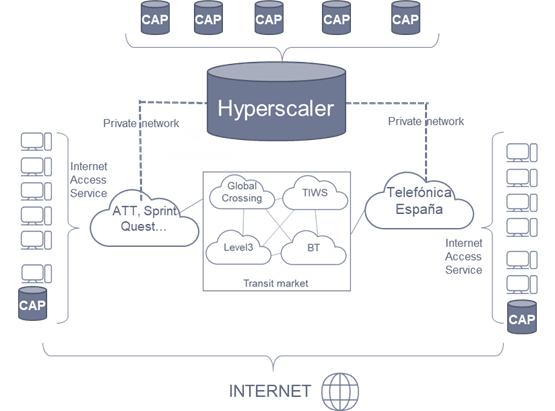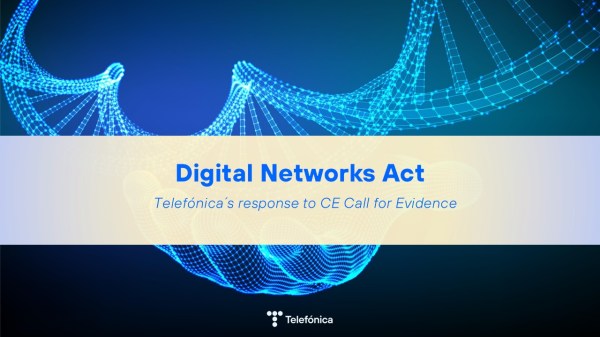The radical change of the Internet in the last ten years
In the cross-cutting arguments and counterarguments on the proposal for a fair contribution of large traffic generators to the cost they induce in telecommunication networks, there is one that deserves special attention. It is often mentioned that this issue was addressed more than ten years ago and failed to gain the necessary support to move forward, and since nothing has changed, it makes no sense to raise it again ten years later. The claim that nothing on the Internet has changed in the last ten years is surprising.
The truth is that in the last ten years everything has changed on the Internet: Internet’s network architecture has changed, business models have changed, the volume of traffic has grown exponentially, and the balance between the companies that make up the Internet ecosystem have shifted.
From the initial internet, based on websites, with a multitude of companies, and a balanced ecosystem between producers and consumers of content, and the telecommunications operators that transport that content, the last decade has seen the consolidation of an internet dominated by a very small number of companies: the hyperscalers. Thanks to their business acumen and the “winner takes all” trend in Internet business models, these companies have achieved a position of dominance in the Internet ecosystem that by 2022 is already unquestionable and incontestable giving rise to a structural problem that requires a solution. This situation has led regions such as the European Union to promote legislative responses such as the Digital Markets Act (DMA).
If there is no denying this reality, all companies and authorities involved in the future and smooth functioning of the digital ecosystem should consider that the time has come to review some of the rules and models that were agreed in the early Internet era, and that no longer fit the reality of 2022. It is time to lay a more solid foundation for the new era of the Internet than the current one, which can only be done based on an understanding of the Internet architecture and its evolution.
Initial Internet architecture
The Internet is a network of networks, made up of thousands of interconnected networks. The interconnection architecture of networks on the Internet was initially hierarchical. There were 3 levels of networks: Tier 1 were global networks whose interconnection ensured full accessibility to any content or any user anywhere in the world; Tier 2 corresponded to regional networks, while Tier 3 were the local networks to which Internet users and content and application providers (CAPs) were connected. Tier 1 is what is traditionally known as the Internet backbone.
In the early stage of the Internet, application and content providers and users connected to an operator that provided the Internet access service, and which was responsible for the connection to a higher-level operator to achieve transit to the global Internet.

As can be seen, the interconnection between the different networks that make up the Internet was done using two different services. When a lower-level network connects to a higher level one, it pays for the so-called transit service. This service allows a user of this network to reach any destination, or access any content, hosted on any network connected to the Internet. Networks at the same level could also interconnect directly using a so-called peering agreement. By directly interconnecting two networks, the use of transit service is avoided. This service gave direct access to the users and content of the two interconnecting networks but did not provide visibility of the users and content of other networks.
On a commercial level, in transit agreements the “downstream” network paid the “upstream” network for the service. In contrast, peering agreements are based on unregulated criteria on the number of users and content providers each network has, and on the traffic exchanged. Since the operators seeking interconnection tended to have similar network structures, the services – and the costs associated with them – provided to each other were comparable. The implicit assumption of network symmetry (especially symmetry in access networks) and costs led in many cases to free peering arrangements based on the assumption that payments made to cover costs incurred on the counterparty’s network would be netted against payments received from that counterparty. The parameter of symmetry in the exchange of traffic became in this early Internet model a guiding criterion in the negotiation of peering agreements.
The flattening of the Internet architecture
The architecture of the Internet had to adapt to the new needs arising from the exponential growth of video traffic (or video streaming). Several elements have been introduced over the years that have drastically changed the Internet architecture. On the one hand, video required capabilities that the basic Internet architecture could not provide. This led to the introduction of one element, CDNs (Content Delivery Networks), clouds specialized in video distribution that reduced the need for increased capacity on higher level networks (1 and 2), and reduced latency (the time it takes for content to reach the end user), thus improving the user experience. On the other hand, as the big hyperscalers grew and consolidated their platform model, they started to build their own selective transport networks (at the most profitable tiers) and their own selective CDN infrastructure.
This change has brought a complete transformation in the technical architecture of the Internet. However, the interconnection business model associated with the initial Internet architecture has not been able to evolve. None of the interconnection rules that were created for the initial Internet have been able to be changed. Or rather we could say that the hyperscalers have not allowed these rules to change, given the benefit they derive from this interconnection model, and leveraging their undisputed market dominance to impose rules and conditions.
With the introduction of these elements, the Internet has evolved over the last ten years into a flatter network where the initial tiers and hierarchy disappear. Those hyperscalers that have reached a position of dominance and sufficient business scale to do so, connect directly to the networks of many operators at their least expensive tiers, bypassing the transit networks, but not as users of the Internet, as they did in the initial stage, but as “Operators” using the peering agreements. The creation of their own infrastructure has allowed the large hyperscalers to avoid not only paying Internet transit costs, but also the cost of distributing their content, thus gaining a competitive advantage over other players who do not have a dominant position and therefore cannot force free peering agreements.
The architecture of the Internet has become highly centralized and dependent on a few players, the big hyperscalers.

Internet Users, Telecom Operators or Content Providers?
The majority of Internet transit traffic is now generated by large hyperscalers. In addition, the delivery of their content to end-consumers bypasses the traditional Internet hierarchy. Today 3 of the top 5 providers of Internet transit connectivity are hyperscalers. These companies can reach most networks directly without going through the Internet hierarchy.
Surely it is time to ask whether the Internet giants are connectivity providers under the supervision of National Regulatory Agencies and subject to their decisions, or they are application and content providers, or Internet users, obliged to pay for the connectivity service received. What is the role they should play in the Internet interconnection model?
The advantage of not paying the costs of using operators’ networks
When traffic from large hyperscalers increased, and when these companies came to aggregate most of the Internet traffic, they created their own private network to avoid transit fees. They downgraded their connection to local operators under traditional conditions and connected to other networks by forcing free peering.
These companies became a “category” not initially envisaged in the Internet interconnection model: they ceased to be Internet users and became “special” network operators with neither an access network nor a national network, but with content that gave them a clearly dominant position in the negotiation of peering agreements.
It is essential to understand that when a hyperscaler negotiates a peering agreement with a telecommunications operator, it does not do so under the same principles on which peering agreements between operators are negotiated. Providing essential content and applications (because of consumer demand) gives them bargaining power that usually results in free peering agreements. They demand the advantage of not having to pay to use the transport service for their traffic provided by operators.
This does not seem to be a sign of balanced bargaining power between operators and large hyperscalers. Rather, it shows the distortion of a market that by not adapting to the evolution of the Internet can only lead to an unsustainable situation, dominated by a few companies that define the rules, the conditions, and that manage to capture most of the value generated in the digital ecosystem.
Mixing the reality of networks with the reality of large hyperscalers in the interconnection market has resulted in a distorted market. The current definition of the Internet interconnection market is no longer relevant, as it does not consider the reality of the new interconnection model based on the CDN and cloud infrastructure of the hyperscalers.
Given that this situation was never envisaged in the original Internet model, it should lead us to think that the time has come to consider whether this is the right foundation for financing the investment effort faced by telecommunications operators to deploy national backbones and access networks.
The essential debate on how to build a fairer and more sustainable digital ecosystem
The debate on the fair contribution of large Internet companies is the debate on the need to review assumptions that were agreed in the 1990s, and that 30 years later are still being applied to an Internet that bears little resemblance to the Internet that was born in the 1990s.
It is legitimate that the companies that have been most favored by these rules want to retain them even in the Web 3.0 era, but there is a broad global consensus that to ensure a fairer and more balanced internet ecosystem, these rules need to be revised. Legitimate counterarguments to the claims of telecommunications operators should be based on data and facts from today’s Internet, not from an Internet that no longer exists.










